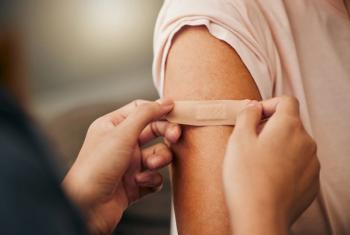
OBESITY: Exploring adult treatments
To date, said Sarah C Armstrong, MD, FAAP, treatments for pediatric obesity have largely been limited to behavioral counseling and addressing comorbidities.
Part of Contemporary Pediatrics’ coverage of the 2015 AAP Annual Conference. For more coverage, click
To date, said Sarah C Armstrong, MD, FAAP, treatments for pediatric obesity have largely been limited to behavioral counseling and addressing comorbidities. However with our increased understanding of obesity over the last 5 to 10 years comes the realization that childhood obesity is generally a physiologic problem stemming from the child and family’s interaction with the environment, said Allen Browne, MD, FAAP. Armstrong and Browne spoke at a session titled “Should Adult Obesity Treatments Be Used to Treat Children with Obesity?”
Rather than children’s behavior fueling obesity, we now appreciate that factors such as a high-added-sugar, low-fiber diet, exposure to obesogenic chemicals, stress, and disruptions of the microbiome and circadian rhythms can drive behaviors that feed obesity.
Healthy eating remains a cornerstone of any treatment plan. Beyond that, some treatments commonly used for adults to target obesity directly merit consideration, although each has advantages and disadvantages in the pediatric population.
Judging from adult experience and limited pediatric experience, said Browne, it’s easy to say that bariatric surgery tops the list of effective treatments for obesity. These procedures, however, are inherently dangerous, permanent, and relatively unadjustable to different life stages. They also require stringent adherence to strict dietary and medical routines that are challenging-perhaps even more so at the adolescent’s developmental stage, said Armstrong.
US Food and Drug Administration-approved medications can drive enough weight loss to resolve some of obesity’s comorbidities, said Browne. Armstrong, however, explained that the risks and benefits of these agents have not yet been studied in children. Compared with at least 6 medications approved for obesity treatment in adults, only one, orlistat, is approved for children aged 12 years and older.
Implantable weight-loss devices are adjustable (even after implantation, to a degree) and removable, said Browne. As with medications, there are no ongoing studies of weight-loss devices in children in the United States.
To increase the array of thoroughly researched options available for obese children, to the extent possible, we must address the delay in translating adult therapies into pediatric populations and the higher bar set for approval of these therapies. There remains a lingering bias among people who still believe that such treatments are optional, and that obesity is more a lifestyle choice than a burgeoning healthcare crisis.
Sarah C Armstrong, MD, FAAP, is an associate professor, pediatrics and community and family medicine, and director, Healthy Lifestyles Clinic, Duke University, Durham, North Carolina.
Allen Browne, MD, FAAP, is an associate professor of surgery, University of Illinois, and codirector, Pediatric Weight Management Clinic, Carle Clinic, Urbana, Illinois.
Commentary
There’s no silver bullet regarding the childhood obesity epidemic. Rather, solving the obesity epidemic requires a shotgun.
The factors that have contributed and have led us to the childhood obesity that we now face are simultaneously simple and complex. Simple, in that we take in too many calories and don’t burn off enough. As Drs Armstrong and Browne point out, however, the influences on this behavioral dynamic are very complex.
One model that helps us understand these factors is the socioecologic model, which considers the many spheres of influence that affect our daily choices. Some individual factors, like our genes, we can’t change. However socioeconomic factors, such as the lack of access to healthy foods in economically distressed neighborhoods and higher rates of crime that may result in parents not allowing their children to play in certain parks, can be changed with concerted effort over time.
Challenges such as these are nearly impossible for individuals to solve by themselves, yet we quickly look to the individual for reasons why a child or an adult might be challenged by their weight.
Treating childhood obesity spans from children who are slightly challenged by their weight to those whose weight is already dramatically impacting their health. Young adults are dying, and their stories are not being told.
One patient I briefly cared for died at the age of 19 years from complications of obesity, likely heavily driven by untreated or undertreated sleep apnea that then led to heart and lung failure. That is atrocious and should not be happening in the United States-or anywhere else for that matter.
For teenagers like this, we need to consider all the options. Childhood obesity science, however, is still a very new field of study. We do not yet really know what approaches will be most successful. One thing is certain: we must remember that we can’t just treat children like small adults. Kids are very different. Their bodies are still growing, and so treatments that might be appropriate for adults are often inappropriate, and even unsafe, for children. So, we must be very careful when recommending potential options.
That said, for some teenagers who are already severely affected by their weight, helping them get to a healthier place might require more intense interventions, possibly including surgeries, devices, or drugs presently used only for adults. For some older teenagers, for example, bariatric surgery could potentially be life-saving. Surgery is not a miracle fix, however. To be successful in this effort, long-term, dramatic lifestyle changes are also essential.
While we try more extreme approaches in an attempt to save those most severely affected today, it is imperative that prevention and efforts leading to healthy community change continue. I very much hope that in the next decade, no teenager will need bariatric surgery, and that one day, we who direct childhood obesity centers will put ourselves out of business.
Stephen J Pont, MD, MPH, FAAP, is an assistant professor of pediatrics at the University of Texas-Austin, and medical director, Texas Center for the Prevention and Treatment of Childhood Obesity, Dell Children’s Medical Center. He chairs the AAP Section on Obesity.
Newsletter
Access practical, evidence-based guidance to support better care for our youngest patients. Join our email list for the latest clinical updates.









